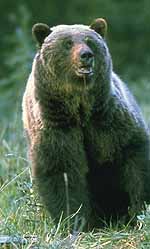|
WHEN HIKING IN BEAR COUNTRY
|
|
Most hikers never see a bear, but much of the North American wilderness is bear country. Whether you plan to hike for days or just a few hours take the time to learn about the special precautions for hiking in bear country.
|
|
|
Don't Surprise Bears |
Let bears know you are coming. They will usually move out of the way if they hear people approaching, so make noise.
Bells are not as effective as many people believe; talking loudly, clapping hands, and calling out are all better ways of making your presence known.
Trail conditions may make it hard for bears to see, hear, or smell approaching hikers. Be careful hiking by a stream, against the wind, or in dense vegetation. A blind corner or a rise in the trail also requires special attention by hikers.
|
|
|
Don't Approach Bears! |
Never intentionally get close to a bear. Individual bears will all react differently and unpredictably. A minimum safe distance from bears is 500-1000 feet, although there is no guarantee of your safety.
|
|
|
Inform Yourself About Bears |
If hiking in a park, forest, or wilderness area, the park staff or rangers can tell you of recent bear activity in the area where you plan to hike. They can also help identify signs of bear activity like tracks, torn-up logs, droppings, and overturned rocks. Bears spend a lot of time eating, so avoid hiking in obvious feeding areas like berry patches, cow parsnip thickets, or fields of glacier lilies.
Although most hikers do not encounter bears, people have been seriously injured, maimed, and killed by bears. All bears are dangerous and should be respected equally. A female with cubs, bears with a fresh kill, and bears conditioned to human food are the most dangerous.
When hiking in bear country, leave an itinerary with friends or in your car which includes beginning and ending times.
Never hike alone, or at night. |
|
Never feed animals or leave food or garbage unattended.
BACK TO TOP
|
|





